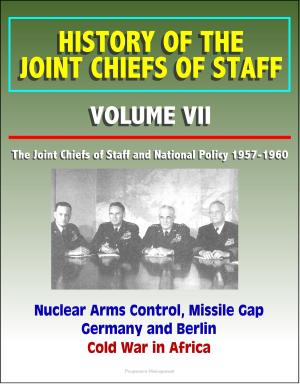Transformation of the German Reichsheer: German Army After World War I, Wehrmacht, General Hans von Seeckt, Nazis and Hitler, Invasions of Poland and France, Operation Barbarossa, Second World War
Nonfiction, History, Germany, Military, World War II| Author: | Progressive Management | ISBN: | 9781311861917 |
| Publisher: | Progressive Management | Publication: | May 20, 2016 |
| Imprint: | Smashwords Edition | Language: | English |
| Author: | Progressive Management |
| ISBN: | 9781311861917 |
| Publisher: | Progressive Management |
| Publication: | May 20, 2016 |
| Imprint: | Smashwords Edition |
| Language: | English |
This excellent report has been professionally converted for accurate flowing-text e-book format reproduction. Following the end of the World War I, the major combatants engaged in varying degrees of reorganization and reformation to incorporate the lessons learned from the conflict. Germany faced the pressing need to quickly reconstitute and reorganize her armed forces to meet both external and internal threats. The Reichsheer (German Army from 1919-1935) was the only major combatant to conduct a thorough and systematic study of the tactical and operational lessons of the war. The Reichswehr transformational efforts in doctrine, reorganization and training laid the foundation for the expansion and early World War II successes of the Wehrmacht. The research question of this thesis was to explore exactly how the Reichsheer leaders transformed their warfighting doctrine. This thesis also looks closely at the underlying organizational philosophy, and how the philosophy guided the Reichsheer leadership cadre in affecting change within the organization. Reichsheer doctrinal manuals, directives and contemporary journal articles, supplemented with American observer reports, served as primary source material for the thesis. The thesis will clearly link the importance of a leader creating and articulating an envisioned end state in successfully effecting change within a military organization.
CHAPTER 1 - INTRODUCTION AND HISTORICAL BACKGROUND * Strategic Context * Military Background to the Reichsheer * Interim Leadership * Treaty Restrictions * General Hans von Seeckt * The German Command and General Staff System * The General Staff in the Great War * Summary * CHAPTER 2 - LEADERSHIP PHILOSOPHY AND DOCTRINAL REFORM * Hans von Seeckt and Versailles * Seeckt's Philosophy and Vision * End State * Analysis and Reform * New Doctrine * Summary * CHAPTER 3 - LEADERSHIP SELECTION, DEVELOPMENT, AND TRAINING * Strategic Context * Soldier and Noncommissioned Officer Career Progression * Officer Accession * Officer Training and Education * General Staff Officer Training * Unit Training * Doctrinal Refinement and Feedback * Summary * CHAPTER 4 - THE PATH TO WAR * Introduction... * The Post-Seeckt Reichsheer * The Nazis Come to Power * The Expansion of the Wehrmacht * The Invasions of Poland and France * Operation Barbarossa * CHAPTER 5 - CONCLUSION * Organizational Philosophy * Articulation and Transmission of Vision * Leadership Selection and Training * Contribution to the Wehrmacht * Observations for Today * Warnings and Cautions * GLOSSARY
This excellent report has been professionally converted for accurate flowing-text e-book format reproduction. Following the end of the World War I, the major combatants engaged in varying degrees of reorganization and reformation to incorporate the lessons learned from the conflict. Germany faced the pressing need to quickly reconstitute and reorganize her armed forces to meet both external and internal threats. The Reichsheer (German Army from 1919-1935) was the only major combatant to conduct a thorough and systematic study of the tactical and operational lessons of the war. The Reichswehr transformational efforts in doctrine, reorganization and training laid the foundation for the expansion and early World War II successes of the Wehrmacht. The research question of this thesis was to explore exactly how the Reichsheer leaders transformed their warfighting doctrine. This thesis also looks closely at the underlying organizational philosophy, and how the philosophy guided the Reichsheer leadership cadre in affecting change within the organization. Reichsheer doctrinal manuals, directives and contemporary journal articles, supplemented with American observer reports, served as primary source material for the thesis. The thesis will clearly link the importance of a leader creating and articulating an envisioned end state in successfully effecting change within a military organization.
CHAPTER 1 - INTRODUCTION AND HISTORICAL BACKGROUND * Strategic Context * Military Background to the Reichsheer * Interim Leadership * Treaty Restrictions * General Hans von Seeckt * The German Command and General Staff System * The General Staff in the Great War * Summary * CHAPTER 2 - LEADERSHIP PHILOSOPHY AND DOCTRINAL REFORM * Hans von Seeckt and Versailles * Seeckt's Philosophy and Vision * End State * Analysis and Reform * New Doctrine * Summary * CHAPTER 3 - LEADERSHIP SELECTION, DEVELOPMENT, AND TRAINING * Strategic Context * Soldier and Noncommissioned Officer Career Progression * Officer Accession * Officer Training and Education * General Staff Officer Training * Unit Training * Doctrinal Refinement and Feedback * Summary * CHAPTER 4 - THE PATH TO WAR * Introduction... * The Post-Seeckt Reichsheer * The Nazis Come to Power * The Expansion of the Wehrmacht * The Invasions of Poland and France * Operation Barbarossa * CHAPTER 5 - CONCLUSION * Organizational Philosophy * Articulation and Transmission of Vision * Leadership Selection and Training * Contribution to the Wehrmacht * Observations for Today * Warnings and Cautions * GLOSSARY















